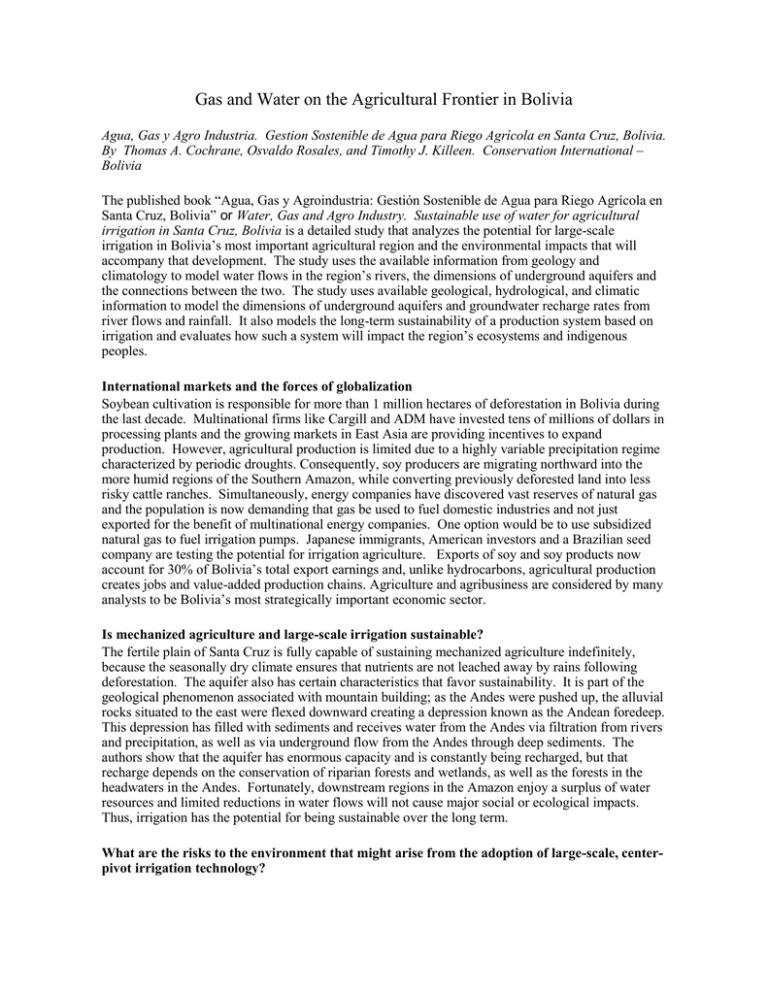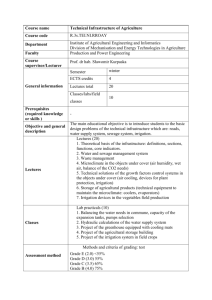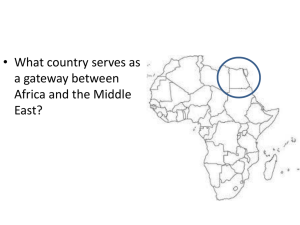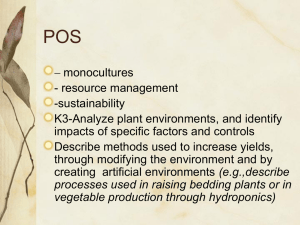12595702_Abstract.doc (30Kb)
advertisement

Gas and Water on the Agricultural Frontier in Bolivia Agua, Gas y Agro Industria. Gestion Sostenible de Agua para Riego Agrícola en Santa Cruz, Bolivia. By Thomas A. Cochrane, Osvaldo Rosales, and Timothy J. Killeen. Conservation International – Bolivia The published book “Agua, Gas y Agroindustria: Gestión Sostenible de Agua para Riego Agrícola en Santa Cruz, Bolivia” or Water, Gas and Agro Industry. Sustainable use of water for agricultural irrigation in Santa Cruz, Bolivia is a detailed study that analyzes the potential for large-scale irrigation in Bolivia’s most important agricultural region and the environmental impacts that will accompany that development. The study uses the available information from geology and climatology to model water flows in the region’s rivers, the dimensions of underground aquifers and the connections between the two. The study uses available geological, hydrological, and climatic information to model the dimensions of underground aquifers and groundwater recharge rates from river flows and rainfall. It also models the long-term sustainability of a production system based on irrigation and evaluates how such a system will impact the region’s ecosystems and indigenous peoples. International markets and the forces of globalization Soybean cultivation is responsible for more than 1 million hectares of deforestation in Bolivia during the last decade. Multinational firms like Cargill and ADM have invested tens of millions of dollars in processing plants and the growing markets in East Asia are providing incentives to expand production. However, agricultural production is limited due to a highly variable precipitation regime characterized by periodic droughts. Consequently, soy producers are migrating northward into the more humid regions of the Southern Amazon, while converting previously deforested land into less risky cattle ranches. Simultaneously, energy companies have discovered vast reserves of natural gas and the population is now demanding that gas be used to fuel domestic industries and not just exported for the benefit of multinational energy companies. One option would be to use subsidized natural gas to fuel irrigation pumps. Japanese immigrants, American investors and a Brazilian seed company are testing the potential for irrigation agriculture. Exports of soy and soy products now account for 30% of Bolivia’s total export earnings and, unlike hydrocarbons, agricultural production creates jobs and value-added production chains. Agriculture and agribusiness are considered by many analysts to be Bolivia’s most strategically important economic sector. Is mechanized agriculture and large-scale irrigation sustainable? The fertile plain of Santa Cruz is fully capable of sustaining mechanized agriculture indefinitely, because the seasonally dry climate ensures that nutrients are not leached away by rains following deforestation. The aquifer also has certain characteristics that favor sustainability. It is part of the geological phenomenon associated with mountain building; as the Andes were pushed up, the alluvial rocks situated to the east were flexed downward creating a depression known as the Andean foredeep. This depression has filled with sediments and receives water from the Andes via filtration from rivers and precipitation, as well as via underground flow from the Andes through deep sediments. The authors show that the aquifer has enormous capacity and is constantly being recharged, but that recharge depends on the conservation of riparian forests and wetlands, as well as the forests in the headwaters in the Andes. Fortunately, downstream regions in the Amazon enjoy a surplus of water resources and limited reductions in water flows will not cause major social or ecological impacts. Thus, irrigation has the potential for being sustainable over the long term. What are the risks to the environment that might arise from the adoption of large-scale, centerpivot irrigation technology? Santa Cruz’s agricultural frontier borders the Kaa Iya National Park and Indigenous Reserve of the Gran Chaco. The limit between the agricultural zone and the protected area is the Parapití River, a small river that feeds water into a seasonal wetland known as the Bañados de Izozog. This hydrological system is the only year-round water resource for the wildlife in the northern reaches of the Gran Chaco. The Parapati River flows out of the mountains with a large caudal but dwindles to a few meters as the water filters into the sandy soils of the alluvial plain. Large-scale irrigation close to the river will draw down water levels and cause the river and wetlands to dry up. If the Bañados de Izozog disappeared for even a few weeks of the year, the wildlife populations of the Gran Chaco would crash, including endemic species such as the endangered Chacoan Peccary. An equally important concern is the potential impact of reduced water levels to indigenous Guaraní villages, which are scattered along the Parapatí. These villages depend on the river and associated shallow wells to grow crops and raise livestock. A disruption in surface waters would imperil their traditional production systems and culture that has withstood colonial and modern pressure over centuries. Use of irrigation might possibly reduce the pressure on tropical forests in Bolivia. By providing other options for increasing production, the government might be able restrict the advance of the agricultural frontier. The book includes several economic models that outline irrigation technologies, crop options, and different sources of energy, including wind power. The study estimates that approximately 300,000 hectares of land, which is currently underutilized as pasture, can be irrigated to produce two crop cycles per year. If combined with other modern agronomic and soil conservation practices, yields could be doubled, thus effectively removing the need to convert 600,000 hectares of forest to farmland, while simultaneously obtaining a 30% increase in agricultural exports. Market based solutions The study demonstrates that the very dry lands adjacent to the strategic wetlands of the Bañados de Izozog are not economically viable as irrigation farmland. The area is so dry and the water requirement of crops so large that the cost of pumping that much water is not profitable. Likewise, the study demonstrates that ecologically strategic wetland habitats along all major river corridors should not be converted to farmland. The flooding associated with rivers not only destroys crops, but also plays an important role in recharging the underground aquifer. River corridors are also key components in any conservation strategy, due to the biodiversity they contain and their role in connecting habitat remnants. These last two points are representative of the orientation of the authors, who are attempting to motivate good environmental policy via economic policy. The traditional method would be to recommend strict land-use zoning regulations to protect the wetlands and river corridors. However, these regulatory mechanisms are notoriously irrelevant in Bolivia, which lacks competent state agencies to enforce them, as well as a culture of responsibility regarding the exploitation of natural resources. The authors instead wish to inform the potential investor in irrigation technology or agricultural production the best way to invest his or her capital, which in this instance is also the best way to minimize damage to the environment. The authors are two hydrologists (Cochrane & Rosales) and conservation biologist (Killeen). The study was financed by a grant made by the CBC-Andes to The Museo Noel Kempff Mercado and donations from by Transredes and GasOriente Bolviano, subsidiary companies to Shell Gas and Prisma International Energy. Prepared by, T. Killeen






